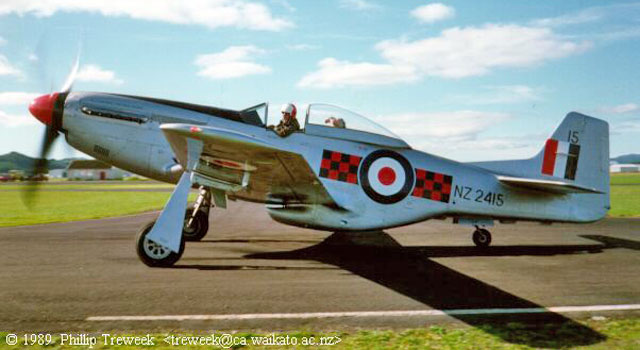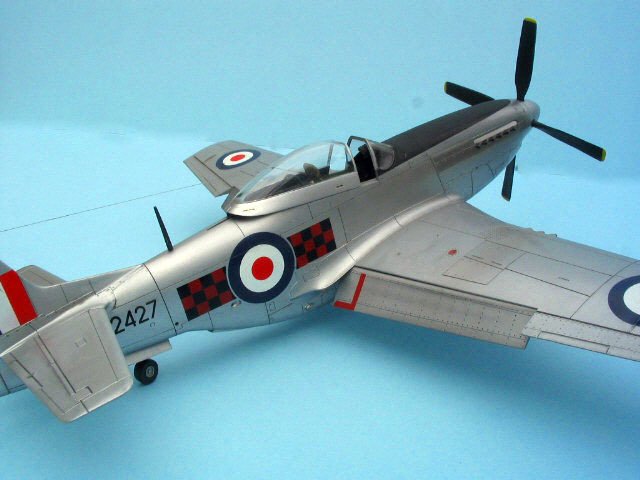|
New Zealand Territorial Air
Force
RNZAF P-51D Mustang
by Jonathan Squires
|
 |
|
P-51D Mustang |

Tamiya's
1/48 scale P-51D Mustang is available online from Squadron.com
The P-51 Mustang in RNZAF Service
Following the end of WWII, the RNZAF undertook a
downsizing program and proceeded to demobilise much of the wartime air
combat force to a peacetime level. In order to partially offset this
reduction in capability, and to maintain pilots’ flying skills, it was
determined that the formation of an Air Force Reserve (known in NZ as
the Territorial Air Force, or TAF) would be necessary. So, in 1948, the
NZ Government ordered the formation of four TAF (Reserve) Squadrons to
supplement the post-war RNZAF. The four squadrons, №’s. 1 (Auckland), 2
(Wellington), 3 (Canterbury) & № 4 (Otago) TAF were initially equipped
with Tiger Moths & Harvard’s. However, in 1951-52, the TAF received a
significant boost in capability (at least relative to a Tiger Moth!)
when it was re-equipped with P51 Mustangs.
The RNZAF came to acquire its P51’s through an
order placed with North American Aviation for 370 P51D Mustangs. These
were originally intended as a replacement for the F4U1 Corsairs that the
Air Force was then operating in the Pacific. However, only 30 P51’s were
delivered to the RNZAF prior to the end of hostilities, the rest of the
order being cancelled before it was sent to NZ. Those that did arrive in
NZ were firstly placed in storage and ultimately issued to the TAF
Squadrons.
The TAF flew its Mustangs from 1951 to late 1955.
The aircraft were popular with their pilots. However, a combination of
the relatively low hours flown, and a subsequent lack of experience on
the type, led to five fatal accidents and a particularly high attrition
rate. Interestingly (to me anyway!), was the incorporation of each
regions provincial rugby colour’s into checkerboard flashings on either
side of the roundels carried on the fuselage.
By 1955 the Air Ministry felt it could no longer
justify the existence of the TAF and chose to remove the Mustangs from
service. Despite this, the four TAF squadrons, once again flying
Harvard’s & Tiger Moths, continued to exist for a short time until their
final dissolution on 1 August 1957. All remaining Mustangs were put up
for sale & mostly scrapped.
The Mustang’s themselves were standard
P51D-30-NT’s, manufactured at the Dallas plant in early 1945 and were
notable only for being equipped with the un-cuffed propeller blade. They
appear to have been well maintained and did not show significant signs
of wear & tear.
Surviving New Zealand Mustangs
Three of the ex-RNZAF Mustangs survived the scrap
heap; two of which are now airworthy again. The aircraft depicted here,
NZ2427, arrived in NZ on 27th August 1945. It was
immediately placed in storage, firstly at Hobsonville, and then Ardmore
Aerodrome. NZ2427 remained in storage until early 1952, when it was
reactivated and allocated to №. 3 (Canterbury) TAF Squadron. It served
with 3 Squadron from October 17, 1952 to August 9, 1955.
Following another three years in storage, NZ2427
was sold to private owners for £80.00. Under its new managers, the
aircraft spent the next 32 years firstly at Omaka aerodrome (near
Blenheim, NZ) where it remained virtually airworthy (but not flying),
then at Peter Coleman’s home (near Omaka). Its last home prior to
restoration was a garage in Blenheim where NZ2427 was partially
disassembled.
In 1990 the remaining components of the airframe
were sold to the Alpine Fighter Collection (Sir Tim Wallis, Wanaka, NZ)
with the intention of restoring it to airworthy condition. Instead of
restoration, though, the aircraft found itself in storage again due to
the acquisition of another complete & airworthy Mustang by the AFC. In
1996 NZ2427 was once again sold, this time to Maurice Hammond from
England as part of a deal that included a partially restored Hurricane
(BW881).

NZ2427 has since been restored to flying condition,
however not in the markings of New Zealand’s TAF but that of “Janie”
from the USAAF’s 353rd Fighter Group when it was based at
Rawdon (Essex) during WWII.
Two other NZ Mustangs survived the dissolution of
the TAF. Following service with № 3 Squadron, NZ2417 was sold to
a private NZ owner. It was rebuilt (using pieces from NZ2409) and flew
in NZ as ZK-CCG from 1964-68. Following another period of storage, it
was in 1974 sold on to an American Museum where it lived until 1983. It
was then sold to Kermit Weeks Air Museum where it now resides in the
markings of “Cripes a Mighty III”.
The last survivor, NZ2423, was first
allocated to № 2 (Wellington) Squadron. In 1955 it was transferred to №
42 Squadron (Ohakea) where it served as Squadron hack until early 1957.
After a short time in storage, the RNZAF sold NZ2423 to a private owner,
who subsequently on sold it in 1964 to a Mr. J Smith. As far as is known
the aircraft remains in storage in Mapua, New Zealand.
There are two other Mustangs currently in NZ, one
of which is based in Auckland. Although not originally an RNZAF Mustang,
the NZ Warbirds Association operates an ex-Indonesian Air Force P51 in
the markings of NZ2415 from № 3 (Canterbury) Squadron (see photo
below).

This is the Tamiya 1/48th scale P51D
Mustang. It is a straightforward kit to build, and makes up into a fine
looking model with few, if any flaws. The only problem I encountered
(other than by my own creation) was the removal of the mould point from
the side of the bubble canopy.
Aftermarket accessories used were a True Details
cockpit & weighted wheels. In addition visible areas of the fuselage
were detailed with pieces of fuse wire. These included the actuating
mechanisms for the rear wheel well doors, the oil cooler shutter and air
intake. Hydraulic lines were added to the main gear, as were photo etch
towing eyes.
This model has suffered from more than its fair
share of re-painting and re-construction!
When built in 2000, it was initially painted using
a Humbrol aluminum. However, this did not look much like Aluminum, so I
decided to strip it off and repaint it using Alclad II. Second time
around the result looked ok, so I finished it off using decals from
Ventura (& the spares box) and moved on.
About three months ago I came across a picture of
NZ2427 and noted not only that the propeller blades were un-cuffed, in
marked contrast to the cuffed ones on my original model, but that I had
applied incorrect sized roundels. In short, my attempt looked nothing
like the real thing! So, after securing some un-cuffed blades through
HyperScale, I planned on effecting a quick fix changeover to correct the
blades and decals. However, before I knew it enthusiasm had the better
of me and the aircraft was in about 17 pieces and lacking any markings
whatsoever!

At this point I started playing around with some
Micromesh polishing pads in an effort to achieve a better aluminum
finish. This was most successful and enlightening – the resultant
polished finish is a great aluminum imitation.
New, correct size roundels were sourced from the
spares box and applied. Unfortunately trouble struck in the application
of the Ventura checkerboard markings. No matter how hard I tried, just
would not stick to the model. Following some advice from Steve Westerby,
I attempted dipping the checkerboards in a 10:1 mix of water and PVA to
help add some more glue to the decal backing. This, in combination with
Micro Sol and a hot rag, was mostly successful. Other markings were
Aeromaster and performed as would be expected.
Once the decals were complete I recalled that
Mustang wings were not actually exposed aluminum – they were painted
silver. So, in order to reflect this, I sprayed a satin varnish on the
wings with the intent of at least making them look different to the rest
of the aircraft. .
Weathering
As far as I can tell from pictures, the NZ TAF
Mustangs were clean, well maintained aircraft. As such, I held back on
applying much in terms of wear & tear. Firstly, panel lines were
highlighted using a wash of 80% isopropyl alcohol, 15% Tamiya Nato Black
and 5% dish wash detergent. This proved remarkably effective.
Exhaust & gun stains were added using a highly
diluted mix of burnt umber, black and smoke, while paint chipping &
propeller blade wear were subtly applied using a silver artists pencil.
Final Details
All the parts I had removed (undercarriage, canopy,
aerials, pitot head etc.) at the beginning of the reconstruction were
reattached and the model was complete (again!).
This model is no show stopper (there are some bad
joint lines visible on the underside of the fuselage), however I found
it to be a rewarding and interesting project to complete. Historically,
it was great. From a modeling perspective, I learnt some new skills, for
example how to polish & apply a panel line wash to Alclad II, how to
remove blemishes from canopies and finally apply some virtually useless
decals to a model.
-
Geoffrey Bently & Maurice Conly.
Portrait of an Air Force. The RNZAF 1937 – 1987.
-
Ross Ewing & Ross MacPherson. The
History of New Zealand Aviation.
-
Classic Wings Magazine, Vol 8, No 1.
“Multi National Mustang”
-
Images of “Janie”
and NZ 2415 courtesy of Phillip Treweek.
www.kiwiaircraftimages.co.nz
-
“New Zealand Military Aircraft Serial
Numbers: RNZAF North American P-51D Mustang”
-
www.adf-serials.com/nz-serials/nz2401.shtml
Click the
thumbnails below to view larger images:
P-51 Mustang
From the RAF to the Mighty Eighth
Special Editions (Aviation) 1 |
|
|
|
|
Author: Michael O'Leary
US Price: $10.95
UK Price: £6.99
Publisher:
Osprey Publishing
Publish Date:
September 15, 1997
Details: 128 pages; ISBN: 1855327147 |
|
|
Model,
Text & Images Copyright © 2004 by Jonathan Squires
except two reference photos Copyright © 2004 by Philip
Treweek from
http://www.kiwiaircraftimages.com
Page Created 29 November, 2004
Last Updated
28 November, 2004
Back to
HyperScale Main Page |
Home
| What's New |
Features |
Gallery |
Reviews |
Reference |
Forum |
Search